Karnak Temple: The Temple of Amun-Ra
Have you ever heard of the Karnak Temple, the largest religious complex in the world? Located in Luxor, Egypt, this massive temple served as the principal religious centre of the god Amun-Re in Thebes during the New Kingdom period. With as many as twenty temples and chapels, it was known as "The Most Select of Places." One of the most remarkable architectural wonders of the complex is the hypostyle hall, consisting of 134 massive columns, with the centre twelve standing at a staggering 69 feet. Let's explore this ancient wonder's fascinating history and features, known as the Temple of Amun-Ra.

Background about Karnak Temple
Located in Luxor, Egypt, the Temple of Amun-Ra in Karnak is one of the most impressive religious complexes in the world.
The site was first developed during the Middle Kingdom and grew in scale as subsequent pharaohs placed their mark on it. It held the main precinct to the god Amun - where the god dwelled on earth - and a working estate for the priestly community who lived on-site.
The main precinct would eventually have as many as 20 temples and chapels dedicated to various gods, including Amun, Mut, and Khonsu.
One of the most impressive features of the site is the Great Hypostyle Hall, with 134 massive columns and the centre twelve standing at 69 feet high. Additionally, the site includes the tallest obelisk in Egypt, made of one piece of red granite and dedicated by the female pharaoh Hatshepsut.
Despite the site's poor state of preservation compared to other temple compounds that survive from ancient Egypt, Karnak still offers scholars a wealth of information about Egyptian religion and art. [1][2]

Importance of the Temple of Amun-Ra
The Temple of Amun-Ra at Karnak is an incredibly important archaeological site that provides insight into the religion and art of ancient Egypt. Here are some of the reasons why the Temple of Amun-Ra is so significant:
- The Temple of Amun-Re was the principal religious centre of the god Amun-Re in Thebes during the New Kingdom period (1550-1070 B.C.E.) and remains one of the largest religious complexes in the world.
- Karnak was not just one temple dedicated to one god but held multiple precincts to various gods, kitchens, workshops, and a sacred lake.
- The complex was known in ancient times as "The Most Select of Places" and served as a place for the god to dwell and a working estate for the priestly community who lived on site.
- The Temple of Amun-Re was the site of numerous celebrations and rituals, including an annual Opet Festival, which included a procession of the cult statue of Amun-Re from the Temple of Karnak to the Temple of Luxor, along with other religious objects and priests.
- The hypostyle hall at Karnak is one of the greatest architectural marvels of ancient Egypt, with 134 massive sandstone columns and brightly painted decorations that remain today. The centre's twelve columns stand at an impressive 69 feet tall. [3][4]
Purpose of the blog post
The of this blog post is to provide readers with a comprehensive understanding of the Karnak Temple and its importance in Egyptian history. The post delves into the temple's rich history, from its development during the Middle Kingdom to the mark made by subsequent pharaohs. It also highlights the significance of the Most Select of Places, the complex's plethora of temples and chapels, and the unique architectural features that make the temple stand out.
The post gives readers a detailed account of the axes and avenues, the tallest obelisk in Egypt, the Festival Temple of Thutmose III, and the hypostyle hall and its unique features. Readers will learn about the purpose of the different buildings within the complex, including the sacred lake, kitchens, and workshops used to produce religious accoutrements.
This blog post emphasizes the importance of preserving Egypt's archaeological heritage and provides readers with an unforgettable experience of exploring the Karnak Temple. By reading this post, scholars, enthusiasts, and those interested in ancient history will greatly appreciate the significance of the Karnak Temple and its role in shaping Egyptian history and culture. [5][6]
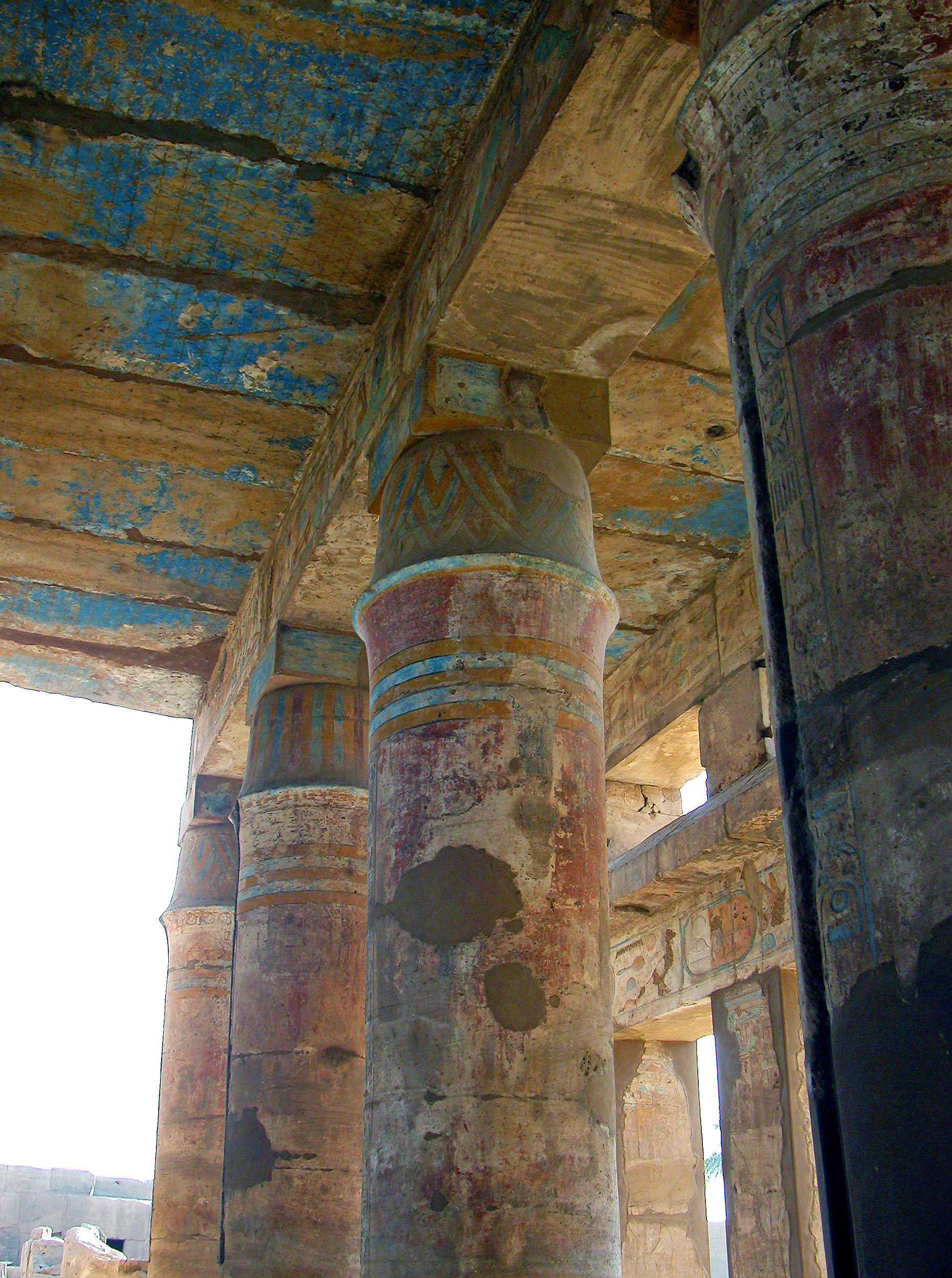
Development during the Middle Kingdom
Kak Temple, also known as the Temple of Amun-Ra, is an impressive religious centre in Thebes, Egypt. The temple complex was initially developed during the Middle Kingdom (2055–1650 B.C.E.) and was modest in scale. However, subsequent pharaohs began to place their mark on Karnak, making it one of the largest religious complexes in the world.
Here are some key aspects regarding the development of Karnak Temple during the Middle Kingdom:
- The site was initially modest in scale.
- Subsequent pharaohs began to increase the complexity and grandeur of the temple complex.
- The main precinct would eventually have as many as twenty temples and chapels.
- Karnak was known in ancient times as The Most Select of Places and was not only the location of the cult image of Amun but also a working estate for the priestly community who lived on site.
- Additional buildings included a sacred lake, kitchens, and workshops for producing religious accoutrements.
Karnak Temple is an impressive testament to the development of religion and architecture in ancient Egypt. Despite being in a poor state of preservation compared to other temple compounds from ancient Egypt, it remains a valuable source of information about Egyptian culture and art. We must continue to preserve and learn from this archaeological heritage. [7][8]
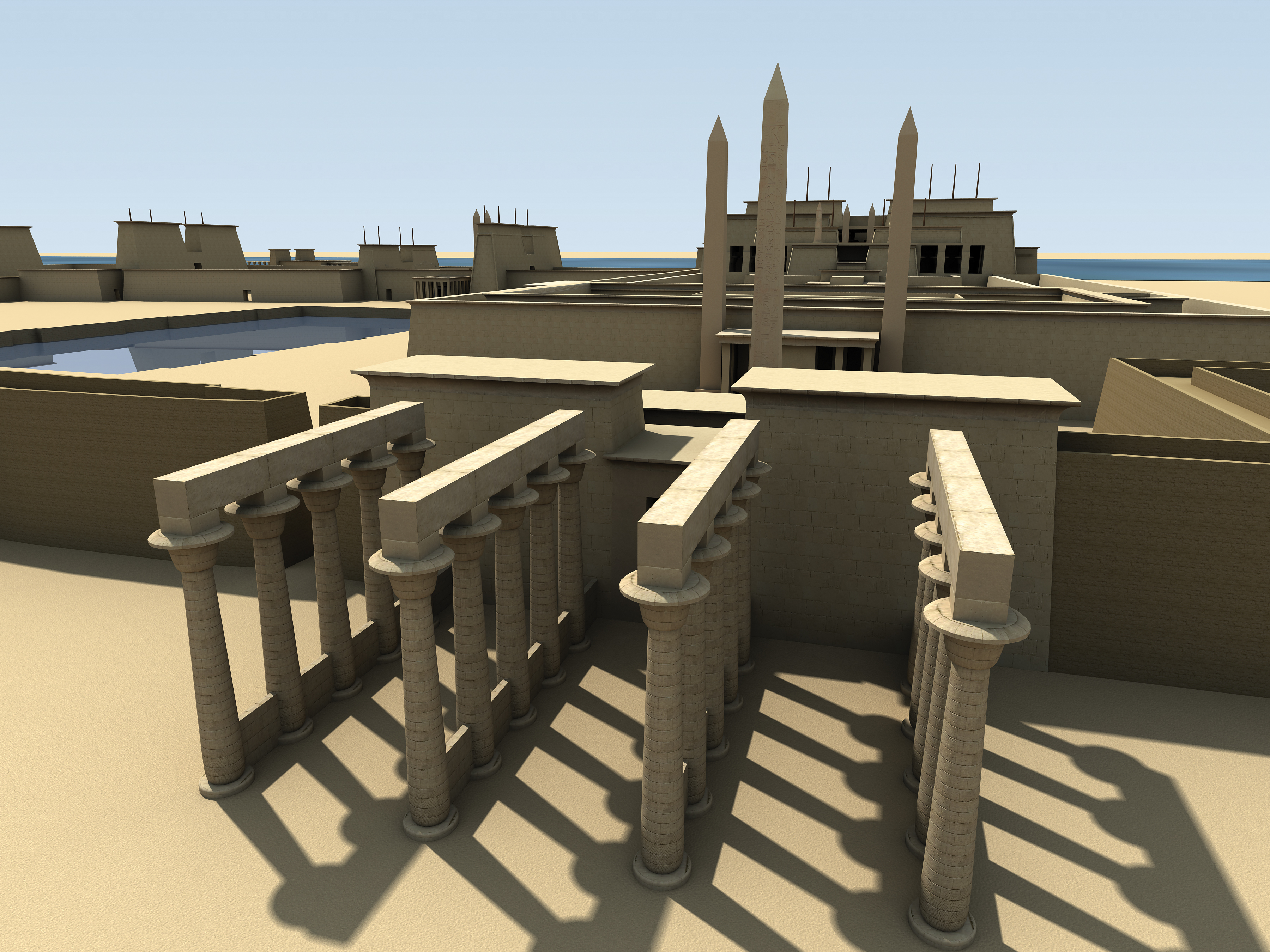
Mark made by subsequent pharaohs.
Beginning in the Middle Kingdom and continuing into the New Kingdom, Karnak Temple saw an expansion and evolution under the rule of subsequent pharaohs. The Temple of Amun-Ra was the central complex, housing the main precinct and the precincts of other gods. With as many as twenty temples and chapels, Karnak was known as "The Most Select of Places" and served as a religious centre and a working estate for the priestly community.
Some of the notable additions made by pharaohs to Karnak include:
- The construction of axes and avenues, including an avenue of ram-headed sphinxes connecting the southern axis to the Temple of Luxor
- The creation of the Festival Temple of Thutmose III with columns designed to look like tent poles
- The dedication of the tallest obelisk in Egypt to Amun-Ra by the female pharaoh Hatshepsut
- The construction of the hypostyle hall, featuring 134 massive sandstone columns and clerestory lighting—one of the greatest architectural marvels of Karnak
Despite some losses due to plundering, Karnak Temple remains one of the largest religious complexes in the world and a significant landmark in Egyptian history. It is a testament to the creativity and ambition of the pharaohs who left their mark on the temple complex and reminded us of the importance of preserving Egypt's rich cultural heritage for future generations. [9][10]

The Most Select of Places and its Significance
Karnak Temple holds a significant place in Egyptian history. It was known in ancient times as "The Most Select of Places" and was the site of the cult image of Amun, which represented a place for the god to dwell on the earth. The temple was also a working estate for the priestly community who lived on site.
The complex contained a sacred lake, kitchens, and workshops for producing religious items. The pharaohs who came after the Middle Kingdom further developed Karnak, and as many as twenty temples and chapels were added to the main precinct.
The temple has a unique history and architectural significance. The Festival Temple of Thutmose III showcases columns representing tent poles, referencing the pharaoh's many war campaigns. The hypostyle hall is another architectural marvel of Karnak, with 134 massive sandstone columns, including the centre twelve columns at 69 feet. The upper portions of the columns and ceiling would have been brightly painted, and some of this paint still exists today.
"The Most Select of Places" at Karnak holds a special place among Egypt's archaeological heritage and represents a significant part of Egyptian religion, art, and history. It must be preserved for future generations to examine and learn from Egypt's rich cultural legacy. [11][12]
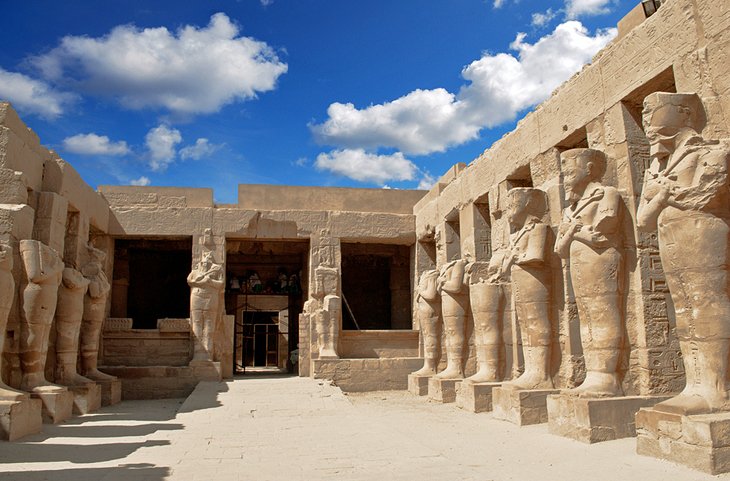
Temples and chapels within the complex
The Karnak Temple, dedicated to the god Amun-Ra, is one of the largest religious complexes in the world. It comprises not only the main precinct of the god but also the precincts of other gods. Built during the Middle Kingdom, it was initially modest in scale, but as new importance was placed on the city of Thebes, subsequent pharaohs began to place their mark on Karnak.
The main precinct would eventually have as many as twenty temples and chapels. "The Most Select of Places" was not only the location of the cult image of Amun but also a working estate for the priestly community who lived on site. Additional buildings included a sacred lake, kitchens, and workshops for producing religious accoutrements.
Some of the notable temples and chapels within the complex are:
- Festival Temple of Thutmose III, with columns that represented tent poles
- The Hypostyle Hall, with 134 massive sandstone columns with the centre twelve columns standing at 69 feet
- Tallest obelisk in Egypt, made of one piece of red granite
- The Temple of Luxor, connected by an avenue of ram-headed sphinxes
- Precinct of Mut, dedicated to the wife of Amun
- Karnak Open Air Museum, a collection of stone buildings of different periods from different locations in Luxor
These temples and chapels provide information about Egyptian religion and art. The Karnak Temple complex remains an important site for scholars to study and uncover the history of ancient Egypt. It is crucial to preserve and protect these archaeological treasures for future generations to learn from and appreciate. [13][14]
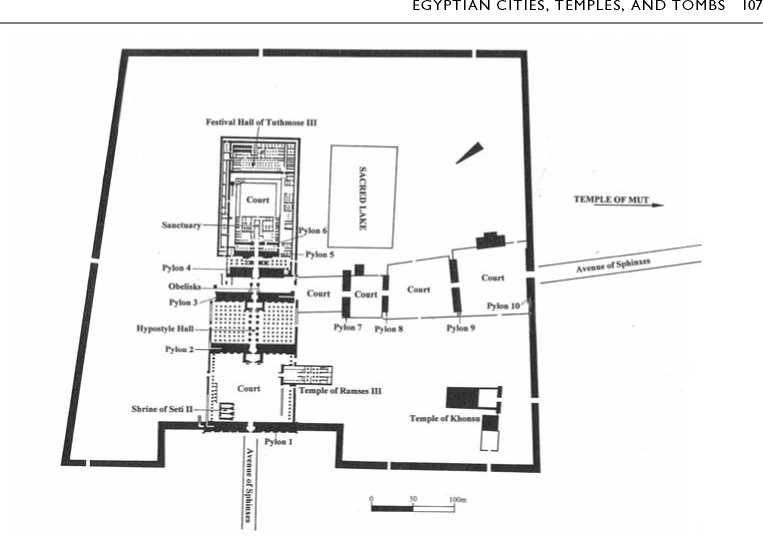
Axes and avenues
The Karnak Temple complex, dedicated to the god Amun-Re, is one of the largest religious centres in the world. Located in Thebes, Egypt, this temple compound is known for its unique architectural features and symbolic importance.
One of the most interesting features of Karnak is the presence of two axes, one going north/south and the other extending east/west. The southern axis continues towards the temple of Luxor and is connected by an avenue of ram-headed sphinxes. Other notable features include the tallest obelisk in Egypt, made of one piece of red granite dedicated by the female pharaoh Hatshepsut, and the Festival Temple of Thutmose III, which had columns representing tent poles.
However, one of the greatest architectural marvels of Karnak is the hypostyle hall, built during the New Kingdom. This hall has 134 massive sandstone columns, with 12 standing at 69 feet, allowing lighting and air into the otherwise dark space below. The columns are brightly painted, making it a sight to behold. Although access to this hall was restricted, it remains one of the most visited attractions in Egypt today. [15][16]
Tallest obelisk in Egypt
The tallest obelisk in Egypt stood at Karnak Temple and was dedicated by the female pharaoh Hatshepsut during the New Kingdom era. Made from a single piece of red granite, its matching obelisk was removed by the Roman emperor Constantine and re-erected in Rome. Here are some fascinating facts about this impressive obelisk:
- The obelisk was around 97 feet (29.5 meters) tall, making it an extraordinary example of monumental architecture.
- With 343 tons, this obelisk is one of the heaviest monuments ever built in ancient Egypt.
- The obelisk was transported from Aswan, a journey of over 200 miles (320 km) on the Nile River, which was a considerable feat of engineering for its time.
- The obelisk's shaft was covered in hieroglyphs, which included an account of the pharaoh's reign and her accomplishments. These hieroglyphs were visible to onlookers because the obelisk was highly polished.
- The obelisk was placed near the Pylon VI and VII of the Temple of Amun, and archaeologists believe it was intended to proclaim the power and strength of Hatshepsut's reign.
Overall, the tallest obelisk in Egypt at Karnak Temple is a testament to the engineering and architectural prowess of the ancient Egyptians. It remains an awe-inspiring monument today, demonstrating the impressive heights to which human endeavour can aspire. [17][18]

Festival Temple of Thutmose III
The Festival Temple of Thutmose III is one of the many remarkable features of the Karnak Temple complex. It was built to celebrate the jubilee of the pharaoh and served as part of the annual Opet Festival. Decorated to resemble a giant tent, complete with awnings and tent poles, this shrine is located at the end of the court with its axis at right angles to the main east-west axis of the temple. The festival hall is enclosed in its walls and has three main parts: a suite of rooms dedicated to the southeast, a solar complex to the northeast, and the festival hall from which the other building areas can be reached. The original entrance was in the southwest corner, and the walls contained the Chamber of Ancestors, where a large inscription shows Thutmose III making offerings to his 61 ancestors.
The Festival Temple of Thutmose III is a testament to the sophistication and grandeur of ancient Egyptian architecture and engineering. It is just one of the many unique features of the Karnak Temple complex that fascinate scholars and visitors alike. Standing amidst the ruins of this ancient religious centre, one cannot help but feel a sense of awe and wonder at the incredible achievements of the ancient Egyptians. As we continue to learn more about this remarkable civilization, we must work to preserve and protect Egypt's archaeological heritage for generations to come. [19][20]

The hypostyle hall and its unique features
The hypostyle hall at Karnak Temple is one of the greatest architectural marvels in Egypt. The hall was built during the New Kingdom period and had 134 massive sandstone columns, with the centre twelve columns standing at an impressive 69 feet. Here are some unique features of this grand structure:
- The hypostyle hall is a space with a roof supported by columns.
- The hall's centre is taller than the spaces on either side, allowing light and air into the otherwise dark space below.
- The upper portions of the columns and ceiling were painted in bright colours to create an incredible visual experience. Some of this paint still exists today.
- The Egyptians allowed for lighting by building a section of the wall that allowed light and air into the hall. This is the earliest evidence of clerestory lighting in Egypt.
- The further one entered the temple, the more restricted access became. Not many ancient Egyptians would have had access to this hall.
The hypostyle hall is a testament to the incredible skill and innovation of the ancient Egyptian architects and builders. It is one of the must-see attractions at Karnak Temple and one of the most significant monuments in Egypt's rich cultural heritage. Efforts should be made to preserve and protect this magnificent structure for future generations. [21][22]

Final thoughts on the Temple of Amun-Ra
The Temple of Amun-Ra at Karnak is a remarkable historic site that provides insight into the culture and beliefs of ancient Egypt. Some final thoughts on this temple are:
- The temple complex of Karnak is one of the largest religious complexes in the world and was the principal religious centre of the god Amun-Re in Thebes.
- It holds not only the main precinct to the god but also the precincts of other gods and would eventually have as many as twenty temples and chapels.
- Karnak was known as "The Most Select of Places" in ancient times and was not only the location of the cult image of Amun but also a working estate for the priestly community who lived on site.
- Some of the unique architectural features within this vast complex include the tallest obelisk in Egypt, the Festival Temple of Thutmose III with its tent pole columns, and the hypostyle hall.
- The hypostyle hall is one of the greatest architectural marvels of Karnak, with 134 massive sandstone columns.
- As an important part of Egypt's archaeological heritage, preserving and protecting sites like the Temple of Amun-Ra at Karnak is crucial for future generations to appreciate and learn from. [23][24]

The importance of preserving Egypt's archaeological heritage.
Egypt's archaeological heritage is a priceless treasure that needs to be preserved for future generations. The country is home to some of the most remarkable ancient structures, including the Temple of Amun-Ra at Karnak. Given the significant role of these structures in Egyptian history and the world, ensuring their preservation is essential. Here are some reasons why preserving Egypt's archaeological heritage is crucial:
1. Cultural Value: Every structure, artefact, or monument unearthed from Egypt's past represents a piece of cultural heritage that tells the story of the country's rich history and culture. By preserving these structures, we ensure that future generations have the opportunity to learn and appreciate this priceless heritage.
2. Historical Importance: Egypt's history has played a significant role in shaping world civilization. By preserving its archaeological heritage, we safeguard this legacy for future generations.
3. Economic Benefit: The country's rich archaeological heritage attracts millions of tourists yearly who come to see its marvels. Preserving these structures ensures they remain intact for years and continue to boost the country's economy through tourism.
4. Awe-Inspiring Inspiration: The grandeur and magnificence of these structures inspire millions of people, motivating them to aspire to greatness and achieve it.
Preserving Egypt's archaeological heritage is imperative to protect the country's cultural, historical, and economic legacy. Our responsibility is to safeguard these treasures, ensuring that future generations can continue to experience their magnificence and draw inspiration from them. [25][26]
